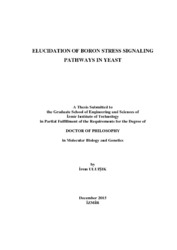Please use this identifier to cite or link to this item:
https://hdl.handle.net/11147/4570Full metadata record
| DC Field | Value | Language |
|---|---|---|
| dc.contributor.advisor | Koç, Ahmet | - |
| dc.contributor.author | Uluışık, İrem | - |
| dc.date.accessioned | 2016-04-28T08:01:33Z | - |
| dc.date.available | 2016-04-28T08:01:33Z | - |
| dc.date.issued | 2015-12 | - |
| dc.identifier.citation | Uluışık, İ. (2015). Elucidation of boron stress signaling pathways in yeast. Unpublished doctoral dissertation, İzmir Institute of Technology, İzmir, Turkey | en_US |
| dc.identifier.uri | http://hdl.handle.net/11147/4570 | - |
| dc.description | Thesis (Doctoral)--Izmir Institute of Technology, Molecular Biology and Genetics, Izmir, 2015 | en_US |
| dc.description | Full text release delayed at author's request until 2018.01.19 | en_US |
| dc.description | Includes bibliographical references (leaves: 60-72) | en_US |
| dc.description | Text in English; Abstract: Turkish and English | en_US |
| dc.description | x, 73 leaves | en_US |
| dc.description.abstract | Boron is an essential micronutrient not only for plants but also for many other organisms. The excess of boron causes toxicity and the mechanism of this toxicity is not known. The yeast Saccharomyces cerevisiae was used as a model system in this study. In order to reveal boron metabolism related genes, a genome-wide screen has been conducted. Among the identified mutants, six boron resistant and eight boron sensitive mutants were chosen for further investigation to understand how cells cope with boron stress. Boron resistant mutants were found to have increased levels of boron efflux pump ATR1 and its transcription activator Gcn4. The sensitive mutants were lacking the genes that are involved in different cellular pathways. They were found to accumulate higher amounts of boron inside the cells upon boron treatment. To reveal how boron stress is conducted to Gcn4 transcription factor, the deletion mutants of transcription factors that are known to regulate GCN4 were investigated in terms of their effects on Gcn4 and ATR1 expression. Additionally, signaling cascades that converge on Gcn4 transcription factor such as TOR, PKA, and SNF1 pathways were analyzed for their roles in boron stress response mechanism. We found that the Gcn system is activated by the uncharged tRNA stress in response to boron treatment and that GCN1, which plays a role in transferring uncharged tRNAs to Gcn2, was necessary for the kinase activity of Gcn2. Additionally, boron treatment caused the phosphorylation of eIF2α in mammalian cells, in a similar manner to that of yeast cells, which suggested that boron toxicity and tolerance mechanisms were conserved between yeast and mammals. | en_US |
| dc.description.abstract | Bor sadece bitkiler için değil pek çok organizma için esansiyel bir mikrobesindir. Bor fazlalığı toksisite oluşturmaktadır ve bu toksisitenin mekanizması bilinmemektedir. Maya Saccharomyces cerevisiae çalışmada model system olarak kullanılmıştır. Bor metabolizması ile ilgili genlerin bulunması amacıyla maya genomu taranmıştır. Bulunan mutantların arasından altı bor dirençli ve sekiz bor duyarlı mutant seçilmiş ve hücrelerin bor stresiyle nasıl başa çıktıklarını anlamak amacıyla daha ileri araştırmalar yapılmıştır. Bor dirençli mutantlarda bir bor pompası olan ATR1 ve aktivatörü Gcn4 seviyelerinin arttığı bulunmuştur. Bor duyarlı mutantların ise farklı hücresel yolaklarda yer alan genleri eksiktir ve bor muamelesi ile hücre içerisinde yüksek miktarlarda bor biriktirdikleri bulunmuştur. Bor stresinin Gcn4 transkripsiyon faktörüne nasıl iletildiğini anlamak için, GCN4’ü regüle ettiği bilinen transkripsiyon faktörlerinin delesyon mutantları Gcn4 ve ATR1 ifadelenmelerine etkileri yönünden incelenmiştir. Ek olarak, Gcn4 transkripsiyon faktöründe birleşen TOR, PKA ve SNF1 gibi sinyal yolakları bor stress yanıt mekanizmasındaki rolleri yönünden analiz edilmiştir. Bor muamelesine yanıt olarak Gcn sisteminin, yüksüz tRNA stresi tarafından aktive edildiği bulunmuştur ve yüksüz tRNA’ların Gcn2’ye transferinde rol oynayan GCN1, Gcn2’nin kinaz aktivitesi için gerekmektedir. Aynı zamanda bor muamelesi, memeli hücrelerinde maya hücrelerine benzer şekilde eIF2α’nın fosfatlanmasına neden olmaktadır. Bu da bor toksisite ve tolerans mekanizmalarının maya ve memelilerde korunmuş olduğunu göstermektedir. | en_US |
| dc.description.sponsorship | TÜBİTAK | en_US |
| dc.language.iso | en | en_US |
| dc.publisher | Izmir Institute of Technology | en_US |
| dc.rights | info:eu-repo/semantics/openAccess | en_US |
| dc.subject | Boron | en_US |
| dc.subject | Yeast | en_US |
| dc.subject | Saccharomyces cerevisiae | en_US |
| dc.title | Elucidation of Boron Stress Signaling Pathways in Yeast | en_US |
| dc.title.alternative | Mayada Bor Stresi Sinyal Yolaklarının Aydınlatılması | en_US |
| dc.type | Doctoral Thesis | en_US |
| dc.institutionauthor | Uluışık, İrem | - |
| dc.department | Thesis (Doctoral)--İzmir Institute of Technology, Molecular Biology and Genetics | en_US |
| dc.relation.publicationcategory | Tez | en_US |
| dc.identifier.wosquality | N/A | - |
| dc.identifier.scopusquality | N/A | - |
| item.openairecristype | http://purl.org/coar/resource_type/c_18cf | - |
| item.languageiso639-1 | en | - |
| item.openairetype | Doctoral Thesis | - |
| item.grantfulltext | open | - |
| item.fulltext | With Fulltext | - |
| item.cerifentitytype | Publications | - |
| Appears in Collections: | Phd Degree / Doktora | |
Files in This Item:
| File | Description | Size | Format | |
|---|---|---|---|---|
| T001433.pdf | DoctoralThesis | 1.88 MB | Adobe PDF |  View/Open |
CORE Recommender
Page view(s)
244
checked on Mar 31, 2025
Download(s)
94
checked on Mar 31, 2025
Google ScholarTM
Check
Items in GCRIS Repository are protected by copyright, with all rights reserved, unless otherwise indicated.